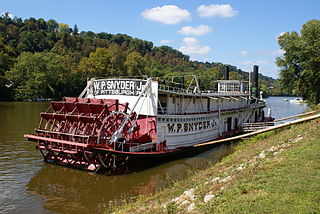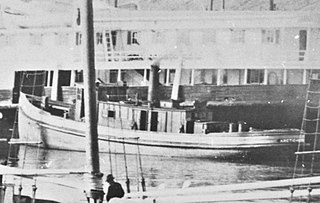
A pusher, pusher craft, pusher boat, pusher tug, or towboat, is a boat designed for pushing barges or car floats. In the United States, the industries that use these vessels refer to them as towboats. These vessels are characterized by a square bow and a shallow draft, and they typically have knees, which are large plates mounted to the bow for pushing barges of various heights. These boats usually operate on rivers and inland waterways. Multiple barges lashed together, or a boat and any barges lashed to it, are referred to as a tow and can have dozens of barges. Many of these vessels, especially the long-haul boats, include living quarters for the crew.

Belle of Louisville is a steamboat owned and operated by the city of Louisville, Kentucky, and moored at its downtown wharf next to the Riverfront Plaza/Belvedere during its annual operational period. The steamboat claims itself the "most widely traveled river steamboat in American history." Belle of Louisville's offices are aboard Mayor Andrew Broaddus, and also appears on the list of National Historic Landmarks.

Effie M. Morrissey is a schooner skippered by Robert Bartlett that made many scientific expeditions to the Arctic, sponsored by American museums, the Explorers Club and the National Geographic Society. She also helped survey the Arctic for the United States Government during World War II. She is currently designated by the United States Department of the Interior as a National Historic Landmark as part of the New Bedford Whaling National Historical Park. She is the State Ship of Massachusetts.

Edward M. Cotter is a fireboat in use by the Buffalo Fire Department at Buffalo, New York, United States. Originally named William S. Grattan, it was built in 1900 by the Crescent Shipyard of Elizabeth Port, New Jersey. Due to age, it was rebuilt in 1953 and renamed Firefighter upon its return to service. The following year it was renamed Edward M. Cotter. its namesake, Edward Cotter, was a Buffalo firefighter and leader of the local firefighters union who had recently died.

Adventure is a gaff rigged knockabout schooner. She was built in Essex, Massachusetts, USA, and launched in 1926 to work the Grand Banks fishing grounds out of Gloucester. She is one of only two surviving knockabout fishing schooners – ships designed without bowsprits for the safety of her crew.

Mayor Andrew Broaddus is a lifesaving station built by the United States Life-Saving Service located in Louisville, Kentucky, off the corner of River Road and Fourth Street. She is named in honor of Andrew Broaddus (1900–1972), a former mayor of Louisville (1953–1957). Her historic purpose was to protect travelers on the Ohio River from the Falls of the Ohio, with rescue crews for those who fell victim to the rapids. Louisville was the first place where a lifesaving station was placed in western waters. The first lifestation in Louisville was in 1881, with Mayor Andrew Broaddus as the third. A National Historic Landmark, she is the only surviving floating lifesaving station of the US Life-Saving Service.

The Majestic is a historic riverboat that is moored on the Ohio River at Greenup, Kentucky. Built in 1923, she was the last floating theater to be built in the United States, and one of its longest-lived. She was declared a National Historic Landmark on December 20, 1989.

George M. Verity is a historic towboat now displayed as a museum ship in Keokuk, Iowa. Built in 1927 as SS Thorpe, she is nationally significant for being one of only three surviving steam-powered towboats in existence in the United States. She was declared a National Historic Landmark in 1989.

Lone Star is a wooden hull, steam-powered stern-wheeled towboat in LeClaire, Iowa, United States. She is dry docked and on display at the Buffalo Bill Museum in LeClaire. Built in 1868, she is the oldest of three surviving steam-powered towboats, and the only one with a wooden hull. She was declared a National Historic Landmark on 20 December 1989.

Sergeant Floyd is a historic museum boat, serving as the Sergeant Floyd River Museum & Welcome Center at 1000 Larsen Park Road in Sioux City, Iowa. Built in 1932 as a utility vehicle and towboat, she is one of a small number of surviving vessels built specifically for the United States Army Corps of Engineers in its management of the nation's inland waterways. The boat has been restored and drydocked, and now houses exhibits about the Missouri River and local tourism information. The museum is a facility of the Sioux City Public Museum.

Luna is a historic tugboat normally berthed in Boston Harbor, Massachusetts. Luna was designed in 1930 by John G. Alden and built by M.M. Davis and Bethlehem Steel. She is listed on the National Register of Historic Places and is a U.S. National Historic Landmark. In 1985, the Luna was designated as a Boston Landmark by the Boston Landmarks Commission.

W. P. Snyder Jr., also known as W. H. Clingerman, W. P. Snyder Jr. State Memorial, or J. L. Perry, is a historic towboat moored on the Muskingum River in Marietta, Ohio, at the Ohio River Museum. A National Historic Landmark, she is the only intact, steam-driven sternwheel towboat still on the nation's river system.

The Rebecca T. Ruark is a Chesapeake Bay skipjack built at Taylor's Island, Maryland. She is homeported at Tilghman Island, Maryland. Built in 1896, she is the oldest surviving skipjack in the Chesapeake Bay fleet. She was designated a National Historic Landmark in 2003.

The William B. Tennison is a Chesapeake Bay bugeye built in 1899 and converted to an oyster buy-boat in 1906–07. With the conversion her sail rig was removed and an engine inserted, and is the only surviving example of this conversion. Her construction marks a transition between log construction and plank construction. She is homeported at the Calvert Marine Museum in Solomons, Maryland. The Tennison is reputed to be the second oldest licensed passenger vessel in the United States.

M/V Mississippi is a United States Army Corps of Engineers (USACE) towboat operating on the Mississippi River. It is the largest diesel towboat on the river.

The Zweig Building is a historic commercial building in downtown Bellaire, Ohio, United States. Constructed in 1912, it is an early example of the Chicago school.

Arctic was a wooden-hulled tugboat that worked on the Great Lakes of North America from 1881 to 1930. In 1930 the Arctic was stripped of her machinery, and abandoned at Manitowoc, Wisconsin. On June 22, 2018, the remains of the Arctic were listed on the National Register of Historic Places.

Sand Man is tugboat museum ship of the Sand Man Foundation at Percival Landing, Olympia, Washington. The Sand Man Foundation is a 501(c)(3) nonprofit organization. Sand Man was built in 1910 by Crawford and Reid in Tacoma, Washington. Sand Man is small harbor tug, built out of old-growth Douglas fir. Sand Man was designed and built by Crawford and Reid in Tacoma, Washington, from 1908 to 1910. The ship's wheel-house was designed and built by the Long family, Olympia. Jake Frisch built the doors and windows in 1910. The hull restoration was completed in 2000 by PT Shipwrights Co-op, in Port Townsend, Washington. The cabins and engine restoration was completed in 2005 by Paul Deranleau and his crew of volunteers in Olympia, after being out of the water for 7 years for work at Swantown Marina. Sand Man originally it had copper sheathing to protect the hull, later this was replaced with ironbark wood sheathing. The ship still has the original Stanley Steamer engine used for the towing winch that is run by compressed air. Only a few of this type of tug remain. From 1910 to 1987 Sand Man operated as a commercial tugboat and towboat in Puget Sound, with home port in Olympia. In 1974 Sand Man ran she first race in Olympia's annual Labor Day tugboat races held in the Olympia Harbor Days Festival. In 1998 Sand Man was listed on the National Register of Historic Places for vessels on August 6, 1998, as #98001018. She is also listed on the registers of Washington state Historic Site, and Historic Site by the City of Olympia.






















